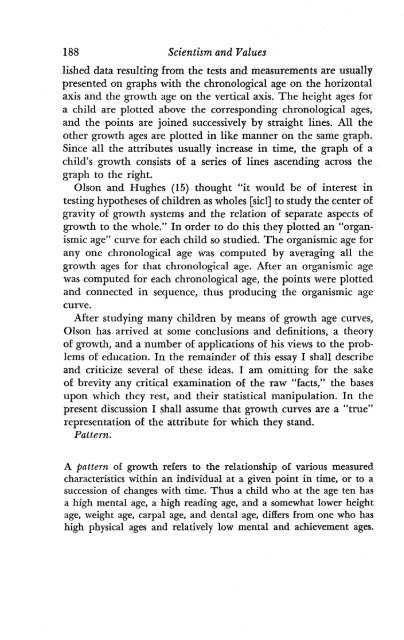Scientism and Values.pdf - Ludwig von Mises Institute
Scientism and Values.pdf - Ludwig von Mises Institute
Scientism and Values.pdf - Ludwig von Mises Institute
You also want an ePaper? Increase the reach of your titles
YUMPU automatically turns print PDFs into web optimized ePapers that Google loves.
188 <strong>Scientism</strong> <strong>and</strong> <strong>Values</strong><br />
lished data resulting from the tests <strong>and</strong> measurements are usually<br />
presented on graphs with the chronological age on the horizontal<br />
axis <strong>and</strong> the growth age on the vertical axis. The height ages for<br />
a child are plotted above the corresponding chronological ages,<br />
<strong>and</strong> the points. are joined successively by straight lines. All the<br />
other growth ages are plotted in like manner on the same graph.<br />
Since all the attributes usually increase in time, the graph of a<br />
child's growth consists of a series of lines ascending across the<br />
graph to the right.<br />
Olson <strong>and</strong> Hughes (15) thought "it would be of interest in<br />
testing hypotheses of children as wholes [sic!] to study the center of<br />
gravity of growth systems <strong>and</strong> the relation of separate aspects of<br />
growth to the whole." In order to do this they plotted an "organismic<br />
age" curve for each child so studied. The organismic age for<br />
anyone chronological age was computed by averaging all the<br />
growth ages for that chronological age. After an organismic age<br />
was computed for each chronological age, the points were plotted<br />
<strong>and</strong> connected in sequence, thus producing the organismic age<br />
curve.<br />
After studying many children by means of growth age curves,<br />
Olson has arrived at some conclusions <strong>and</strong> definitions, a theory<br />
of growth, <strong>and</strong> a number of applications of his views to the problems<br />
of education. In the remainder of this essay I shall describe<br />
<strong>and</strong> criticize several of these ideas. I am omitting for the sake<br />
of brevity any critical examination of the raw "facts," the bases<br />
upon which they rest, <strong>and</strong> their statistical manipulation. In the<br />
present discussion I shall assume that growth curves are a "true"<br />
representation of the attribute for which they st<strong>and</strong>.<br />
Pattern.<br />
A pattern of growth refers to the relationship of various measured<br />
characteristics within an individual at a given point in time, or to a<br />
succession of changes with time. Thus a child who at the age ten has<br />
a high mental age, a high reading age, <strong>and</strong> a somewhat lower height<br />
age, weight age, carpal age, <strong>and</strong> dental age, differs from one who has<br />
high physical ages <strong>and</strong> relatively low mental <strong>and</strong> achievement ages.
















